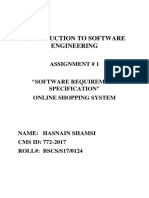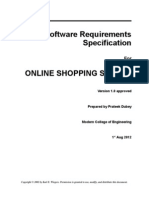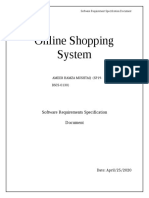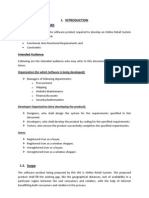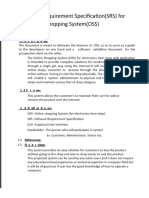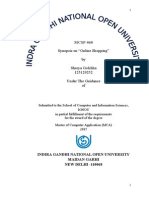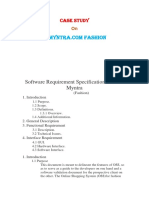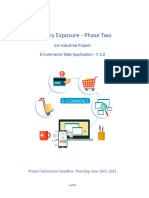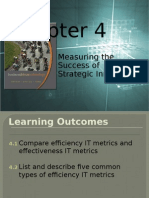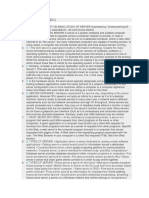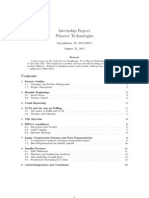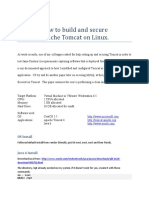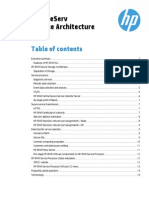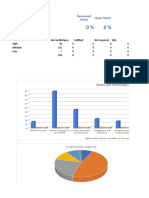Software Requirements
Specification
for
<Online Shopping System>
Prepared by <Muhammad Qasim>
<2015-ag-5611>
<UAF>
<23-04-2018>
Copyright © 1999 by Karl E. Wiegers. Permission is granted to use, modify, and distribute this document.
�Table of Contents
Table of Contents ...........................................................................................................................2
Revision History .............................................................................................................................2
1. Introduction ..............................................................................................................................3
1.1 Purpose............................................................................................................................................. 3
1.2 Document Conventions .................................................................................................................... 3
1.3 Intended Audience and Reading Suggestions .................................................................................. 3
1.4 Product Scope .................................................................................................................................. 4
1.5 References ........................................................................................................................................ 4
2. Overall Description ..................................................................................................................4
2.1 Product Perspective.......................................................................................................................... 4
2.2 Product Functions ............................................................................................................................ 5
2.3 User Classes and Characteristics ..................................................................................................... 6
2.4 Operating Environment .................................................................................................................... 6
2.5 Design and Implementation Constraints .......................................................................................... 6
2.6 User Documentation ........................................................................................................................ 7
2.7 Assumptions and Dependencies ...................................................................................................... 7
3. External Interface Requirements ............................................. Error! Bookmark not defined.
3.1 User Interfaces ................................................................................................................................. 7
3.2 Hardware Interfaces ......................................................................................................................... 8
3.3 Software Interfaces .......................................................................................................................... 8
3.4 Communications Interfaces ............................................................................................................. 8
4. System Features .......................................................................................................................9
4.1 System Feature 1 .............................................................................Error! Bookmark not defined.
4.2 System Feature 2 (and so on) ..........................................................Error! Bookmark not defined.
5. Other Nonfunctional Requirements .......................................................................................9
5.1 Performance Requirements .............................................................................................................. 9
5.2 Safety Requirements ........................................................................................................................ 9
5.3 Security Requirements ..................................................................................................................... 9
5.4 Software Quality Attributes ........................................................................................................... 10
5.5 Business Rules ............................................................................................................................... 10
6. Other Requirements ..............................................................................................................10
Appendix A: Glossary..................................................................................................................11
Appendix B: Analysis Models ......................................................... Error! Bookmark not defined.
Appendix C: To Be Determined List .............................................. Error! Bookmark not defined.
Revision History
Name Date Reason For Changes Version
Nill Nill Nill Nill
Copyright © 1999 by Karl E. Wiegers. Permission is granted to use, modify, and distribute this document.
�1. Introduction
The computers and computer applications are finding its voyage to each and
every field of mankind, where the data and information are the primary
necessities. The actual processing of the system becomes very useful to its users
because manipulation and utilization of data in a meaningful way is the need of
each and every organization.
1.1 Purpose
This document is meant to delineate the features of OSS, so as to serve as a guide
to the developers on one hand and a software validation document for the
prospective client on the other. The Online Shopping System (OSS) for furniture
shop web application is intended to provide complete solutions for vendors as
well as customers through a single get way using the internet. It will enable
vendors to setup online shops, customer to browse through the shop and
purchase them online without having to visit the shop physically. The
administration module will enable a system administrator to approve and reject
requests for new shops and maintain various lists of shop category.
1.2 Document Conventions
This system provides an easy to solution customer’s to buy the product without
go to the shop and also shop owner to sale the product.
1.3 Intended Audience and Reading Suggestions
OSS- Online shopping System (for furniture shop)
SRS- Software Requirement Specification
GUI- Graphical User Interface
Copyright © 1999 by Karl E. Wiegers. Permission is granted to use, modify, and distribute this document.
�1.4 Product Scope
This system allows the customer’s to maintain their cart for add or remove the
product over the internet.
1.5 References
www.w3schools.com
www.google.com www.lynda.com
2. Overall Description
2.1 Product Perspective
Copyright © 1999 by Karl E. Wiegers. Permission is granted to use, modify, and distribute this document.
�2.2 Product Functions
This section provides requirement overview of the system Various functional
modules that can be implemented by the system will be
Registration
If customer wants to buy the product then he/she must be registered,
unregistered user can’t go to the shopping cart.
Login:
Customer logins to the system by entering valid user id and password for the
shopping.
Changes to Cart:
Changes to cart means the customer after login or registration can make order or
cancel order of the product from the shopping cart.
Payment:
For customer there are many type of secure billing will be prepaid as debit or
credit card, post paid as after shipping, check or bank draft. The security will
provide by the third party like Pay-Pal etc.
Logout:
After the payment or surf the product the customer will logged out.
Report Generation:
After all transaction the system can generate the portable document file (.pdf)
and then sent one copy to the customer’s Email-address and another one for the
system data base to calculate the monthly transaction .
Copyright © 1999 by Karl E. Wiegers. Permission is granted to use, modify, and distribute this document.
� Technical Issues:
This system will work on client-server architecture. It will require an internet
server and which will be able to run PHP application. The system should support
some commonly used browser such as IE etc.
2.3 User Classes and Characteristics
Stockholder- The person who will participate in system
Ex. Customer, Administrator, Visitor etc.
2.4 Operating Environment
Processor : Pentium or Higher.
RAM : 312MB or Higher.
Operating System : Unix, Linux, Mac, Windows etc..
Development tool : PHP : Hypertext Preprocessor,
JavaScript, Ajax
Data Base : MySQL
2.5 Design and Implementation Constraints
The system shall be built using a standard web page development tool that
conforms to Microsoft’s GUI standards like HTML, XML etc.
The main constraint here would be the checking the genuineness of the buyer,
which is not always possible. There can be security risks involved.
The developed system should run under any platform (Unix, Linux, Mac,
Windows etc.. ) that contains a web browser which supports PHP, JavaScript and
AJAX.
Copyright © 1999 by Karl E. Wiegers. Permission is granted to use, modify, and distribute this document.
�2.6 User Documentation
There are 3 kinds of users for the proposed system.
Administrators : Administrators are the ones who adds or administers the
categories for the products, and administers the Vendors.
Vendors/Sellers : Vendors/Sellers will add their products to the database,
which will be seen in the website to the end users or say customers who can buy
the products by selecting the one they need. Vendors will have the special
privileges than the end users, and have ability to manage the products added by
them.
End Users/Customers : The end user will be the one who visits the website and
buys products online from the ones added by the Vendors/Sellers.
2.7 Assumptions and Dependencies
The product does require back-end database server MYSQL for storing the
username and password for different types of users of the system as well as
various database regarding various insurance information.
User must be trained for basic computer functionalities.
User must have the basic knowledge of English.
The system must be able to respond to database software within reasonable
time.
3 External Interface Requirements
3.1 User Interfaces
Each part of the user interface intends to be as user friendly as possible. The fonts
and buttons used will be intended to be very fast and easy to load on web pages.
The pages will be kept light in space so that it won’t take a long time for the page
to load.
Copyright © 1999 by Karl E. Wiegers. Permission is granted to use, modify, and distribute this document.
�Various interfaces for the product could be-
1. Login Page
2. Registration Form
3. There will be a screen displaying information about product that the shop
having.
4. If the customers select the buy button then another screen of shopping
cart will be opened.
5. After all transaction the system makes the selling report as portable
document file (.pdf) and sent to the customer E-mail address.
3.2 Hardware Interfaces
The System must run over the internet, all the hardware shall require to connect
internet will be hardware interface for the system. As for e.g. Modem, WAN –
LAN, Ethernet Cross-Cable.
3.3 Software Interfaces
The system is on server so it requires the any scripting language like PHP, VBScript
etc. The system require Data Base also for the store the any transaction of the
system like MYSQL etc. system also require DNS(domain name space) for the
naming on the internet. At the last user need web browser for interact with the
system.
3.4 Communications Interfaces
The Website Order system shall send an e-mail confirmation to the customer that
the items they ordered will be delivered to the shipping address along with user
identification.
Copyright © 1999 by Karl E. Wiegers. Permission is granted to use, modify, and distribute this document.
� 4 System Features
The System must run over the internet, all the hardware shall require to connect
internet will be hardware interface for the system.
As for e.g. Modem, WAN – LAN, Ethernet Cross-Cable.
5 Other Nonfunctional Requirements
5.1 Performance Requirements
There is no performance requirement in this system because the server request
and response is depended on the end user internet connection.
5.2 Safety Requirements
Sensitive data will be encrypted before being sent over insecure connections like
the internet.
5.3 Security Requirements
The system use SSL (secured socket layer) in all transactions that include
any confidential customer information.
The system must automatically log out all customers after a period of
inactivity.
The system should not leave any cookies on the customer’s computer
containing the user’s password.
The system’s back-end servers shall only be accessible to authenticated
administrators.
Sensitive data will be encrypted before being sent over insecure
connections like the internet.
Copyright © 1999 by Karl E. Wiegers. Permission is granted to use, modify, and distribute this document.
� 5.4 Software Quality Attributes
Operating System : Unix, Linux, Mac, Windows etc..
Development tool : PHP : Hypertext Preprocessor, JavaScript, Ajax
Data Base : MySQL
5.5 Business Rules
A business rule is anything that captures and implements business policies and
practices. A rule can enforce business policy, make a decision, or infer new data
from existing data. This includes the rules and regulations that the System users
should abide by. This includes the cost of the project and the discount offers
provided. The users should avoid illegal rules and protocols. Neither admin nor
member should cross the rules and regulations.
6 Other Requirements
Availability
The system should be available at all times, meaning the user can access it using a
web browser, only restricted by the down time of the server on which the system
runs. In case of a of a hardware failure or database corruption, a replacement
page will be shown. Also in case of a hardware failure or database corruption,
backups of the database should be retrieved from the server and saved by the
administrator. Then the service will be restarted. It means 24 X 7 availability.
Maintainability
A commercial database is used for maintaining the database and the application
server takes care of the site. In case of a failure, a re-initialization of the program
will be done. Also the software design is being done with modularity in mind so
that maintainability can be done efficiently.
Copyright © 1999 by Karl E. Wiegers. Permission is granted to use, modify, and distribute this document.
�Portability
The application is HTML and scripting language based. So The end-user part is
fully portable and any system using any web browser should be able to use the
features of the system, including any hardware platform that is available or will
be available in the future.
An end-user is use this system on any OS; either it is Windows or Linux.
The system shall run on PC, Laptops, and PDA etc.
Appendix: Glossary
NILL
The End
Copyright © 1999 by Karl E. Wiegers. Permission is granted to use, modify, and distribute this document.
